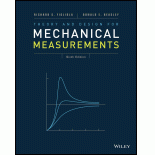
A J-type thermocouple monitors the temperature of air flowing through a duct. Its signal is measured by a thermostat. The air temperature is maintained constant by an electric heater whose power is controlled by the thermostat. To test the control system, 20 measurements of temperature were taken over a reasonable time period during steady operation. This was repeated three times with the following results:
| Run | N | r[°c] | 5r[°C] |
| 1 | 20 | 181.0 | 3.01 |
| 2 | 20 | 183.1 | 2.84 |
| 3 | 20 | 182.1 | 3.08 |
The thermocouple itself has an instrument error with uncertainty ± I °C (95%) with v = 30. It has a 90% rise time of 20 ms. Thermocouple insertion errors are estimated to be ±1.2 °C (95%). What information is found by performing several replications? Identify the elemental errors that affect the system’s control of the air temperature. What is the uncertainty in the set temperature?
Want to see the full answer?
Check out a sample textbook solution
Chapter 5 Solutions
Theory and Design for Mechanical Measurements
- (read image)arrow_forwardQu 2 Schematically plot attractive, repulsive, and net energies versus interatomic separation for two atoms or ions. Note on this plot the equilibrium separation (distance) ro and the bonding energy Eo. Qu 3 How many atoms (or molecules) are in one mole of the substance? Qu 4 Mole, in the context of this book, is taken in units of gram-mole. On this basis, how many atoms are there in a pound-mole of a substance? Qu 5 The atomic radii of Mg* and F ions are 0.072 and 0.133 nm, respectively. Calculate the force of attraction between these two ions at their equilibrium interionic separation (i.e., when the ions just touch one another). What is the force of repulsion at this same separation distance?show all work step by step problems formulaarrow_forwardQu 4 Silver has FCC crystal structure at room temperature, and a lattice constant, a, of 0.407 nm. Draw a reduced sphere silver unit cell in the grids provided below, clearly label the lattice dimensions. Within the unit cell you drew, shade the (1 0 0) plane. How many atoms are contained within the (1 0 0) plane? Calculate the area of (1 0 0) plane in [nm?]. Express your answer in [nm?] to three significant figures. Calculate the planar density of the (1 0 0) plane in [atoms/nm?]. Express the answer in atoms/nm to three significant figures. show all work step by steparrow_forward
- Can I get help on this question?arrow_forwardDuring some actual expansion and compression processes in piston–cylinder devices, the gases have been observed to satisfy the relationship PVn = C, where n and C are constants. Calculate the work done when a gas expands from 350 kPa and 0.03 m3 to a final volume of 0.2 m3 for the case of n = 1.5. The work done in this case is kJ.arrow_forwardCarbon dioxide contained in a piston–cylinder device is compressed from 0.3 to 0.1 m3. During the process, the pressure and volume are related by P = aV–2, where a = 6 kPa·m6. Calculate the work done on carbon dioxide during this process. The work done on carbon dioxide during this process is kJ.arrow_forward
 Principles of Heat Transfer (Activate Learning wi...Mechanical EngineeringISBN:9781305387102Author:Kreith, Frank; Manglik, Raj M.Publisher:Cengage Learning
Principles of Heat Transfer (Activate Learning wi...Mechanical EngineeringISBN:9781305387102Author:Kreith, Frank; Manglik, Raj M.Publisher:Cengage Learning
